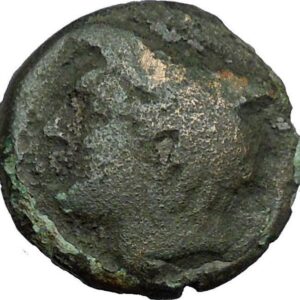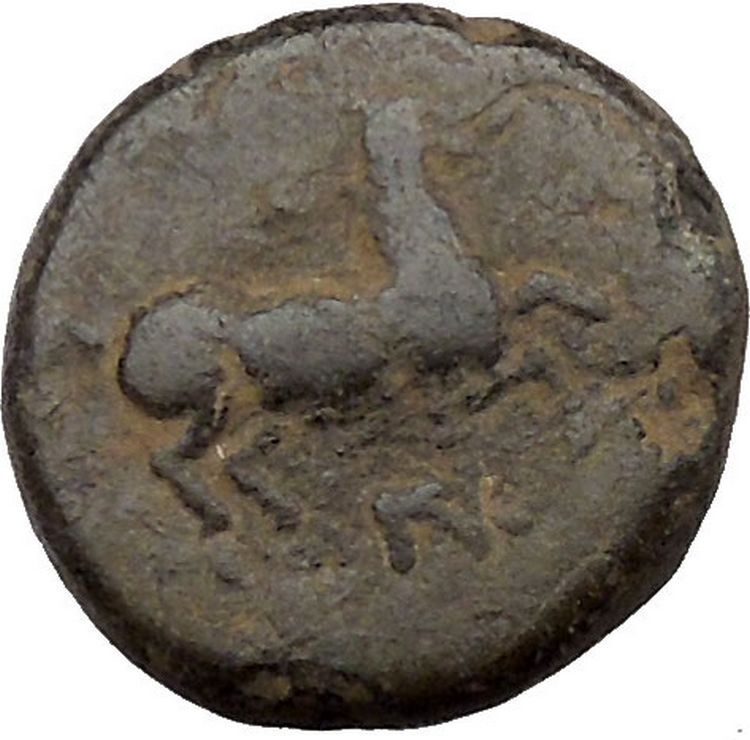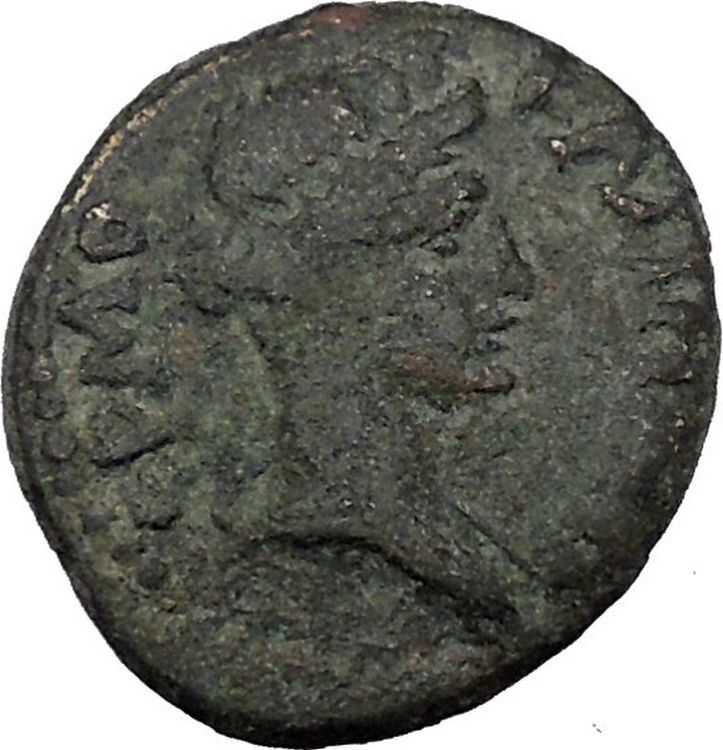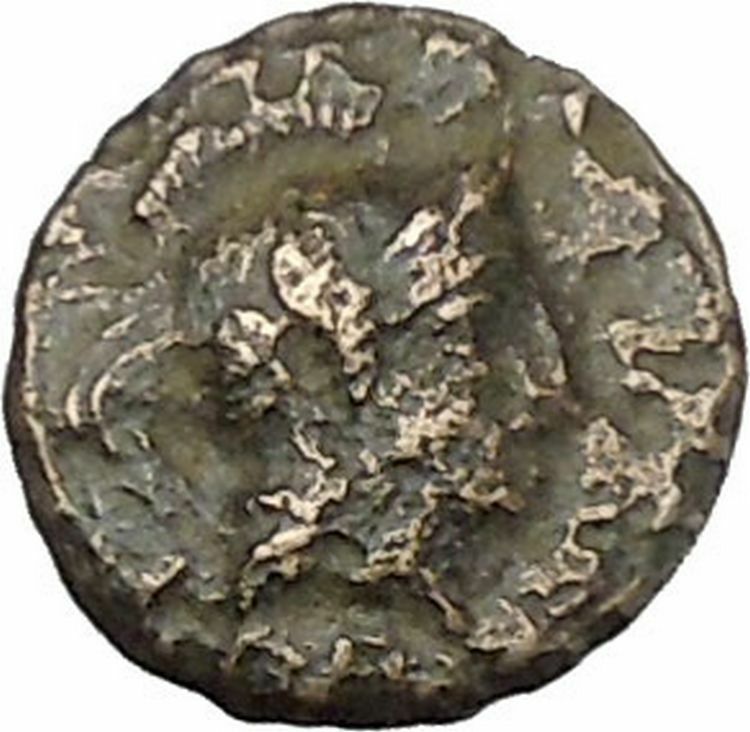|
Greek city of
Myrina in
Aeolis
Bronze 16mm (3.11 grams) Struck 2nd-1st centuries B.C.
Reference: Sear 4219 var.; BMC 27-31.
Laureate head of Apollo right.
MY-PI either side of amphora; lyre to right.
Situated north-east of Kyme, Myrina was overshadowed by its
powerful neighbor, though it appears to have been a place of some importance in
Hellenistic times.
You are bidding on the exact item pictured,
provided with a Certificate of Authenticity and Lifetime Guarantee of
Authenticity.

In
Greek
and
Roman mythology
,
Apollo, is one of the most
important and diverse of the
Olympian deities
. The ideal of the
kouros
(a beardless youth), Apollo has been
variously recognized as a god of light and the sun; truth and prophecy;
archery
; medicine and healing; music, poetry,
and the arts; and more. Apollo is the son of
Zeus and Leto
, and has a
twin
sister, the chaste huntress
Artemis
. Apollo is known in Greek-influenced
Etruscan mythology
as Apulu. Apollo was
worshiped in both
ancient Greek
and
Roman religion
, as well as in the modern
Greco
–Roman
Neopaganism
.
As the patron of Delphi
(Pythian Apollo), Apollo was an
oracular
god — the prophetic deity of the
Delphic Oracle
. Medicine and healing were
associated with Apollo, whether through the god himself or mediated through his
son Asclepius
, yet Apollo was also seen as a god
who could bring ill-health and deadly
plague
as well as one who had the ability to
cure. Amongst the god’s custodial charges, Apollo became associated with
dominion over
colonists
, and as the patron defender of herds
and flocks. As the leader of the
Muses (Apollon Musagetes) and director of their choir, Apollo
functioned as the patron god of music and
poetry
.
Hermes
created the
lyre for him, and the instrument became a common
attribute
of Apollo. Hymns sung to Apollo were
called paeans
.
In Hellenistic times, especially during the third century BCE, as Apollo
Helios he became identified among Greeks with
Helios
,
god of the sun
, and his sister Artemis
similarly equated with
Selene
,
goddess of the moon
. In Latin texts, on the
other hand, Joseph Fontenrose declared himself unable to find any conflation of
Apollo with
Sol
among the
Augustan poets
of the first century, not even
in the conjurations of
Aeneas
and
Latinus
in
Aeneid
XII (161–215). Apollo and Helios/Sol
remained separate beings in literary and mythological texts until the third
century CE.
An amphora (plural:
amphorae or amphoras) is a type of
vase-shaped, usually
ceramic
(specimens in materials such as metal
occur occasionally) container with two handles and a long neck narrower than

the
body. The word amphora is
Latin
, derived from the
Greek
amphoreus (αμφορεύς),
an abbreviation of amphiphoreus, a compound word combining amphi-
(“on both sides”, “twain”) plus phoreus (“carrier”), from pherein
(“to carry”), referring to the vessel’s two carrying handles on opposite sides.
Further, the term also stands for an ancient
Roman unit of measurement
for liquids. The
volume of a Roman amphora was one cubic
foot
, ca. 26,026
L
.
Amphorae were used in vast numbers to transport and store various products,
both liquid and dry, in the ancient
Mediterranean
world and later the
Roman Empire
, and in some periods the shape was
also used for luxury pottery, which might be elaborately painted. Stoppers of
perishable materials which have rarely survived were used to seal the contents.
Two principal types of amphorae existed: the neck amphora, in which the
neck and body meet at a sharp angle; and the one-piece amphora, in which
the neck and body form a continuous curve. Neck amphorae were commonly used in
the early history of ancient Greece but were gradually replaced by the one-piece
type from around the 7th century BCE onwards. Most were produced with a pointed
base to allow upright storage by being partly embedded in sand or soft ground.
This also facilitated transport by ship, where the amphorae were tightly packed
together, with ropes passed through their handles to prevent breaking or
toppling during rough seas. In kitchens and shops amphorae could be stored in
racks with round holes in them.
Amphorae varied greatly in height. The largest could stand as much as 1.5
metres (5 ft) high, while some were under 30 centimetres (12 in) high – the
smallest were called amphoriskoi (literally “little amphorae”). Most were around
45 centimetres (18 in) high. There was a significant degree of standardisation
in some variants; the wine amphora held a standard measure of about 39 litres
(41 US qt), giving rise to the amphora quadrantal as a unit of measure in the
Roman Empire. In all, around 66 distinct types of amphora have been identified.
Myrina (Greek:
Μυρίνα), was one of the
Aeolian
cities on the western coast of
Mysia
, about 40
stadia
to the southwest of
Gryneium
.
Its site is believed to be occupied by the modern
Sandarlik
at the mouth of the
Koca Çay
.
It is said to have been founded by one Myrinus before the other Aeolian
cities,
or by the Amazon
Myrina
.
Artaxerxes
gave Gryneium and Myrina to
Gongylus
,
an Eretrian
,
who had been banished from his native city for favoring the interests of
Persia
.
Myrina was a very strong place,
though not very large, and had a good harbor.
Pliny
mentions that it bore the surname of Sebastopolis; while, according to
Syncellus
,
it was also called Smyrna. For some time Myrina was occupied by
Philip of Macedon
; but the
Romans
compelled him to evacuate it, and declared the place free.
It twice suffered severe earthquakes; first in the reign of
Tiberius
,
on which occasion it received a remission of duties on account of the loss it
had sustained; and a second time in the reign of
Trajan
.
The town was restored each time, and continued to exist until a late period.
Myrina minted coins in antiquity, some of which survive.
|










